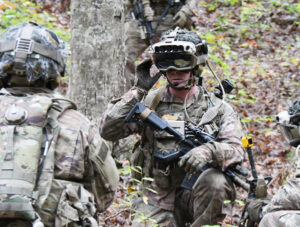Early analysis of data collected from the operational test of the Army’s new Integrated Visual Augmentation System (IVAS) headset is showing “positive signs” of improvements with the capability, according to the service’s top acquisition official.
Doug Bush, assistant secretary of the Army for acquisition, logistics and technology, told Defense Daily
on Monday that officials are now conducting full data analysis following the conclusion of initial operational test and evaluation (IOT&E) for IVAS, which senior leaders have called a critical period for the future of the program.

“It’s early, but I am seeing positive signs that we made significant improvements [to IVAS] which was the goal of delaying the test to ensure the technology was better,” Bush said, speaking to Defense Daily following his remarks at a National Defense Industrial Association event on Joint All Domain Command and Control.
Army Secretary Christine Wormuth told the Senate Appropriations Defense Subcommittee in May that the Army’s evaluation of IVAS coming out of IOT&E will determine whether the service moves forward with the program (Defense Daily, May 10).
Wormuth, at the time, also expressed confidence in the program and its future trajectory as the new Microsoft [MSFT]-built headset was set to move into IOT&E, which was delayed from its original late FY ‘21 start date to allow for further enhancements to the capability.
Bush said a part of IOT&E was aimed at assessing both the performance of the technology itself and the human factors around how soldiers use the new headset.
“I’m coming at it from two perspectives. The technology itself, did it perform better and up to standard in terms of the networking, the display, the hardware and software? Did the technology itself work good enough to be able to go to the next step? But there’s also a human factor. So it’s not just technology, but it’s technology on a soldier. Is it in a form that allows them to do their mission better?” Bush said. “We want IVAS, the first version, to be good enough to where it contributes to [soldiers’] mission success. But a lot of that is not just the technology, it’s the human factors part because it’s a system on a soldier.”
The Army last March awarded Microsoft a deal worth up to $21.9 billion over the next 10 years to move the IVAS program from rapid prototyping into production, with Bush noting the plan is to continue iteratively improving the system (Defense Daily, March 31 2021).
“We should be constantly improving it,” Bush told Defense Daily.
Wormuth also told the Senate Armed Services Committee in May that senior Army officials “did not fully agree” with the findings in a recent Pentagon inspector general’s report that stated the Army “did not define minimum user acceptance levels” for the IVAS program and risks potentially ‘wasting’ $22 billion if soldiers don’t want to use the new headset. (Defense Daily, May 5).
House appropriators’ version of the fiscal year 2023 defense spending bill, which was advanced out of committee on June 22, includes a $400 million cut for IVAS procurement, withholding the funds while the service waits to conclude its operational evaluation of the new headset (Defense Daily, June 21).
“With questions still outstanding regarding the production viability of IVAS, the committee cannot recommend additional procurement funding until after a full review of the results of IOT&E,” the lawmakers wrote in a report accompanying the defense spending bill.